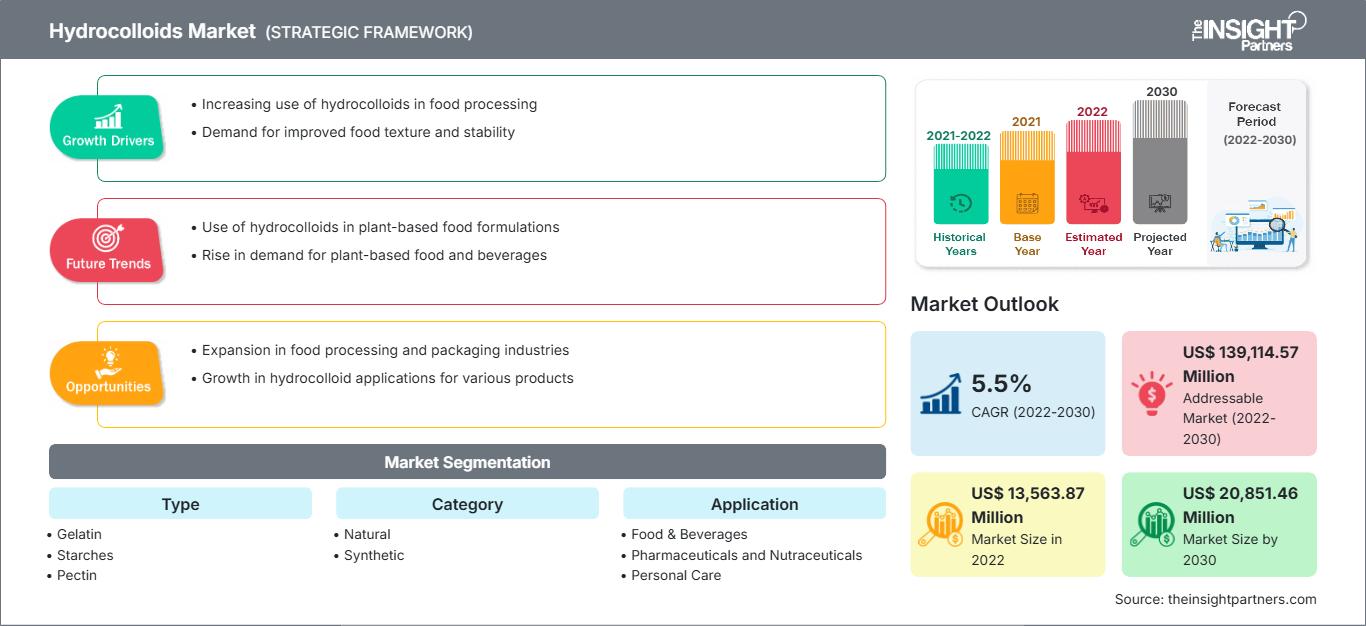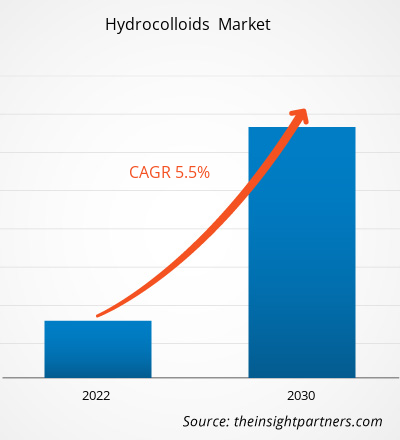[研究报告] 预计水胶体市场规模将从2022年的135.6387亿美元增长到2030年的208.5146亿美元;预计2022年至2030年期间的复合年增长率为5.5%。
市场洞察与分析师观点:
水胶体是从植物、藻类和海藻中提取的。它们也可以通过微生物合成来生产。这些聚合物具有优异的增稠、粘合和胶凝能力。明胶、果胶、琼脂、黄原胶、卡拉胶、结冷胶、海藻酸盐、瓜尔胶、刺槐豆胶 (LBG)、改性淀粉、纤维素、几丁质和壳聚糖是用于食品饮料、药品、保健食品、个人护理产品、动物饲料和宠物食品以及其他工业产品的各种类型的水胶体。由于人口增长、城市人口增加、生活方式改变和繁忙的工作日程,全球食品和饮料行业持续蓬勃发展,推动了对包括水胶体在内的各种食品成分的需求,从而促进了水胶体市场的增长。
增长动力与挑战:
消费者非常关注他们的饮食,他们会关注产品标签以及加工食品和饮料中使用的添加剂。有机和清洁标签产品因其公认的健康益处而越来越受欢迎。它们不含农药、化肥和转基因生物 (GMO),这增加了它们对愿意支付更高价格的消费者的吸引力。此外,消费者越来越青睐不含合成色素、香精和其他添加剂的清洁标签食品。他们也注重使用符合道德标准的添加剂,做出全面、明智的消费选择。因此,预计未来几年,对天然添加剂的需求将激增,成为水胶体市场的新趋势。
自定义此报告以满足您的要求
您将免费获得任何报告的定制,包括本报告的部分内容,或国家级分析、Excel 数据包,以及为初创企业和大学提供超值优惠和折扣
水胶体市场: 战略洞察

- 获取本报告的主要市场趋势。这个免费样本将包括数据分析,从市场趋势到估计和预测。
您将免费获得任何报告的定制,包括本报告的部分内容,或国家级分析、Excel 数据包,以及为初创企业和大学提供超值优惠和折扣
水胶体市场: 战略洞察

- 获取本报告的主要市场趋势。这个免费样本将包括数据分析,从市场趋势到估计和预测。
报告细分和范围:
全球水胶体市场根据类型、类别、应用和地域进行细分。根据类型,市场细分为明胶、淀粉、果胶、黄原胶、卡拉胶、藻酸盐等。根据类别,市场分为天然和合成。在应用方面,水胶体市场分为食品和饮料、药品和营养保健品、个人护理和其他应用。食品和饮料部门的市场进一步细分为烘焙和糖果;乳制品和冷冻甜点;肉类、家禽和海鲜;饮料;和其他。按地域划分,水胶体市场大致分为北美、欧洲、亚太地区 (APAC)、中东和非洲 (MEA) 以及南非和中美洲。北美市场进一步细分为美国、加拿大和墨西哥。欧洲水胶体市场细分为德国、法国、英国、意大利、俄罗斯和欧洲其他地区。亚太地区市场进一步细分为中国、印度、日本、澳大利亚、韩国和亚太其他地区。中东和非洲地区的水胶体市场细分为南非、沙特阿拉伯、阿联酋和中东和非洲其他地区。南美洲和中美洲市场分为巴西、阿根廷和南美洲和中美洲其他地区。
细分分析
根据类型,明胶部分占据水胶体市场的最大份额;卡拉胶部分预计将在 2022 年至 2030 年期间录得最快的复合年增长率。卡拉胶是从红藻中提取的,具有优异的胶凝和增稠性能。由于红藻日益增长的经济意义和潜在的健康益处,以及卡拉胶和琼脂在食品、化妆品、药品和膳食补充剂中的广泛应用,卡拉胶越来越受欢迎。因此,卡拉胶需求的增长预计将利好亲水胶体市场。
按类别划分,天然成分在2022年占据了亲水胶体市场的较大份额。预计该类别在2022年至2030年期间的复合年增长率将更高。由于合成/化学食品添加剂可能对消费者健康造成不良影响,对天然来源成分的需求正在上升。消费者越来越注重产品标签,并且更喜欢带有透明标签的产品。
区域分析:
在所有主要区域中,亚太地区在 2022 年占据了亲水胶体市场的主导地位。2022 年该地区的市场价值为 50.3662 亿美元。北美是全球市场的第二大贡献者,约占 27% 的市场份额。美国是亲水胶体的重要市场,因为对方便食品的需求不断增长,这与快速的生活方式以及包装食品和饮料在烹饪和便携消费方面提供的便利相一致。亲水胶体广泛用于包装/加工食品和饮料中,作为增稠剂、胶凝剂和乳化剂。此外,水胶体还能作为稳定剂,延长产品的整体保质期。
行业发展与未来机遇:
水胶体市场主要参与者采取的各种举措如下:
- 2021年2月,瑞士公司Jungbunzlauer以“TayaGel”品牌推出了高酰基结冷胶。该产品是各种食品(例如乳制饮料和乳制品替代品)的卓越稳定剂。
- 2021年10月,Tilley Co.收购了专业水胶体经销商Ingredient Solutions Inc.。此次收购将有助于该公司扩大其水胶体产品组合。
水胶体水胶体市场区域洞察
水胶体市场区域洞察
The Insight Partners 的分析师已详尽阐述了预测期内影响亲水胶体市场的区域趋势和因素。本节还讨论了北美、欧洲、亚太地区、中东和非洲以及南美和中美的亲水胶体市场细分和地域分布。
水胶体市场报告范围
| 报告属性 | 细节 |
|---|---|
| 市场规模 2022 | US$ 13,563.87 Million |
| 市场规模 2030 | US$ 20,851.46 Million |
| 全球复合年增长率 (2022 - 2030) | 5.5% |
| 历史数据 | 2021-2022 |
| 预测期 | 2022-2030 |
| 涵盖的领域 |
By 类型
|
| 覆盖地区和国家 | 北美
|
| 市场领导者和主要公司简介 |
|
水胶体市场参与者的密度:了解其对业务动态的影响
由于消费者偏好的不断变化、技术进步以及对产品优势的认知度不断提高等因素,终端用户需求不断增长,推动了水胶体市场快速增长。随着需求的增长,企业正在扩展产品线,不断创新以满足消费者需求,并抓住新兴趋势,从而进一步推动市场增长。

- 获取 水胶体市场 主要参与者概述
COVID-19 的影响:
COVID-19 疫情影响了北美、欧洲、亚太地区 (APAC)、南美和中美 (SAM) 以及中东和非洲 (MEA) 等多个国家的几乎所有行业。这些地区的封锁、旅行限制和企业倒闭阻碍了食品饮料、制药和营养保健品行业的增长。制造部门的关闭扰乱了全球供应链、制造活动、交付时间表以及必需和非必需产品的销售。许多公司都出现并宣布产品交付延迟,同时预测 2020 年其产品销量将下滑。所有这些因素都对全球水胶体市场产生了负面影响。
在 COVID-19 疫情期间,由于消费者认为天然产品比传统产品更健康,对天然和清洁标签产品的需求急剧增加。这一因素推动了食品和饮料行业对水胶体的需求。此外,由于对可持续性问题的日益关注,在疫情期间,对纯素、零残忍、天然和草本等个人护理产品的需求也随之增加。这一因素表明,个人护理和化妆品领域的天然水胶体市场具有强劲的增长潜力。此外,2021 年,各国政府宣布放宽封锁、贸易壁垒和企业停工等限制措施,带动市场复苏。此外,制造商获准满员运营,这有助于他们克服供需缺口。
竞争格局和主要公司:
全球水胶体市场排名前 10 的公司包括嘉吉公司、ADM、宜瑞安、帝斯曼、JM Huber、泰特化工Lyle Plc、Kerry Group Plc、Gelita AG、International Flavors & Fragrances Inc 和 American International Foods Inc. 这些公司专注于开发植物性、天然、有机和清洁标签的掩味成分,预计将在未来几年开辟新的增长机会。
- 历史分析(2 年)、基准年、预测(7 年)及复合年增长率
- PEST和SWOT分析
- 市场规模、价值/数量 - 全球、区域、国家
- 行业和竞争格局
- Excel 数据集
近期报告
客户评价
购买理由
- 明智的决策
- 了解市场动态
- 竞争分析
- 客户洞察
- 市场预测
- 风险规避
- 战略规划
- 投资论证
- 识别新兴市场
- 优化营销策略
- 提升运营效率
- 顺应监管趋势






















 获取免费样品 - 水胶体市场
获取免费样品 - 水胶体市场